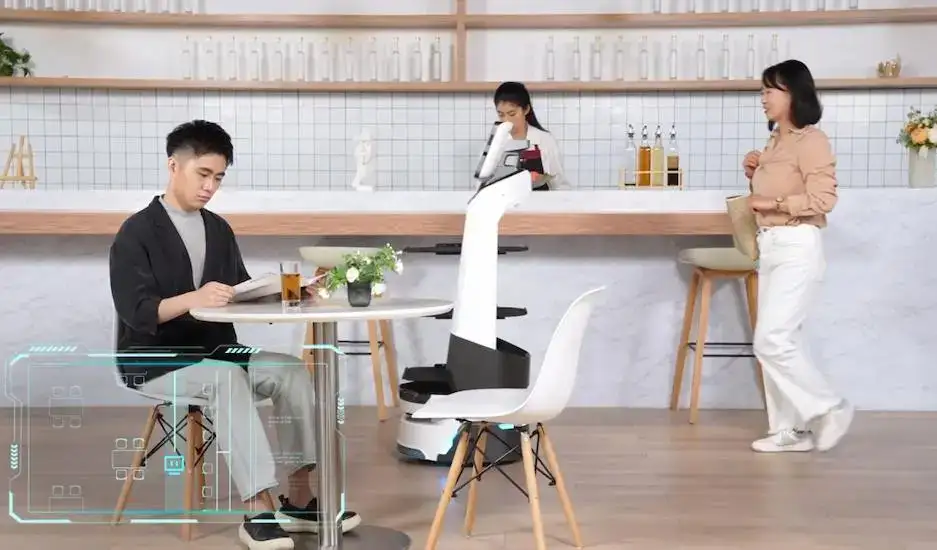We’ve all had those moments—waiting anxiously for a server during a hectic dinner rush, hoping to order and eat right away, or desperately needing room service in a hotel but facing delays with no staff in sight. The arrival of robot waiters offers a clever solution to these woes. Today, we see them popping up in restaurants and hotels, blending novel experiences with impressive efficiency. But are they really the future of restaurant service? Let’s dive into what robot waiters are, how they serve, their pros and cons, and if it is worth investing in. Keep reading to learn more!


Navigation: Using LIDAR sensors, cameras, and mapping software, robot servers can move through busy dining rooms without bumping into tables or people. They follow pre-set paths or adapt in real-time to obstacles. For example, the LuckiBot Pro excels in navigating complex environments efficiently, ensuring reliable service even during peak hours.
Order Delivery: Staff load food onto the robot’s trays, input the table number, and send it off. Some advanced models even integrate with a restaurant’s POS (Point of Sale) system for seamless operation.
Customer Interaction: Certain restaurant robot waiters like the LuckiBot Pro feature touchscreens or voice recognition. They can recommend signature dishes, and guide customers to their seats to enhance the overall dining experience.
Return and Recharge: After completing each food delivery task, the robot automatically returns to the serving point. And it will head back to the charging station when its battery level drops below 10% (this threshold can be adjusted), ensuring efficient operation throughout the day.
Pros
Solves Staffing Shortages: During peak seasons or sudden rushes, finding enough temporary staff can be a real challenge. In these situations, renting robot waiters offers a smart and timely solution, helping to ease the workload and keep service levels steady when human resources are stretched thin.
Boosts Efficiency: Robot waiter restaurants can help cut down wait times and increase table turnover, especially during busy periods. For example, the LuckiBot Pro comes with a three-tier tray design that can carry 6–8 dishes at once and deliver to multiple tables in one trip. This reduces the need for servers to constantly walk back and forth, which helps improve overall service flow.
Attracts Attention: Diners are drawn to the futuristic appeal of robots in restaurants, often sharing their experiences on social media, which doubles as free marketing.
Reliable Performance: Robots don’t get tired or have off days. Their consistency ensures a dependable level of service on every single shift.
Increases Revenue Potential: By handling food delivery and dish collection more efficiently, robots can help turn tables faster. So human staff have more time to engage with customers, upsell drinks or desserts, and ultimately boost both restaurant earnings and server tips.
Cons
Upfront Investment: While the long-term benefits are promising, the initial investment for restaurant robots can still feel significant for some businesses—especially when considering integration, training, and maintenance. However, flexible leasing options can help lower the entry barrier.
Limited Human Touch: Robots are efficient, but they don't pick up on subtle cues like a guest’s mood or tone. Unlike human servers, they can’t offer that warm, personal touch or emotional sensitivity. That said, upcoming advancements like OrionStar’s Agent OS are making robot interactions more natural and engaging.
Potential Technical Glitches: Like any machine, robots aren’t immune to occasional hiccups, whether it's a navigation issue or a system bug. Even with strong after-sales support, minor disruptions can still happen, so it’s important to plan for quick responses and routine maintenance.
OrionStar Robot Waiter has a professional after-sales team, and experts will provide professional technical support for any problems encountered during the use of the product.
Restaurant Type: Fast-casual or high-volume venues like hot pot restaurants, buffets, or large cafeterias benefit most from robot server restaurants, as speed, efficiency, and smooth coordination are essential for these places. For fine dining or boutique spots that emphasize personal service and storytelling, robots might be better used as a supporting tool rather than the main attraction.
Budget: If you're considering buying a robot outright, the upfront cost might feel steep and could take time to offset through labor savings. However, with leasing options available, many restaurants find the cost easy to manage—and even cost-effective—especially during peak seasons when temporary staff are hard to find.
Customer Base: Younger, tech-savvy diners tend to enjoy the novelty and convenience of robot service, often sharing the experience on social media. On the other hand, more traditional guests may still prefer that warm, human interaction—so it’s all about knowing your audience and striking the right balance.
Staffing Needs: If you’ve been struggling to hire or retain waitstaff—a challenge many restaurants continue to face post-pandemic—robot waiters can offer much-needed support. They’re not a replacement for great staff, but they can ease the load by handling repetitive tasks, freeing up your team to focus on delivering excellent service.
Robot waiters are really shaking things up in the dining world! They’re fast, reliable, and add a fun, modern touch that customers love. While they have some drawbacks, these smart helpers have huge potential to make dining out more efficient and enjoyable. If you’re curious about trying it for yourself, the LuckiBot Pro could be just what you need to take your restaurant’s service to the next level. Give it a go and see how it can make things easier for you and more fun for your guests!